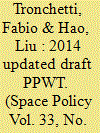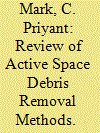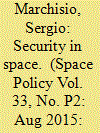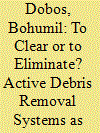|
|
|
Sort Order |
|
|
|
Items / Page
|
|
|
|
|
|
|
| Srl | Item |
| 1 |
ID:
142582


|
|
|
|
|
| Summary/Abstract |
On June 10, 2014, Russia and China presented the updated Draft Treaty on the Prevention of the Placement of Weapons in Space, the Threat or Use of Force Against Space Objects (PPWT) to the Conference on Disarmament. The original 2008 Draft PPWT had been poorly received and criticized, inter alia, for not addressing the most pressing threats to space objects, strategically favoring the interests of its co-sponsors and lacking reliable means of verification.
In presenting the 2014 update the Russian and Chinese representatives pointed out that it had been drafted by taking into account the criticism leveled to its 2008 version and that it should be now viewed as an international effort rather than as a mere Chinese and Russian initiative: they also added that for this reason the amended Draft PPWT constituted a solid instrument to enhance the security of space objects and stood a higher chance of success than its predecessor.
It is, thus worth wondering whether the positive attitude and high expectations of China and Russia towards the amended Draft should be shared or rejected (counteracted, opposed). The present paper gives a rather negative answer to this question. While proceeding to a substantial re-wording and re-organization of its text, the amended Draft maintains the most controversial and debatable aspects of its 2008 version. Therefore, it seems unlikely that delegations within the CD might support it.
Despite its overall negative assessment, the present paper argues that the submission of 2014 updated Draft PPWT may positively contribute, at least indirectly, to the security of space objects. The likely failure of the amended draft could be used by the CD members as an opportunity to focus their efforts in putting in place legal barriers to selected threats to space objects, such as the testing of destructive, debris-generating, ASAT devices. There are elements to believe that a ban on destructive ASAT tests could be achieved and acceptable by the majority of States.
|
|
|
|
|
|
|
|
|
|
|
|
|
|
|
|
| 2 |
ID:
138225


|
|
|
|
|
| Summary/Abstract |
With the rising number of man-made space objects, space situational awareness becomes increasingly important for space faring nations. International cooperation and exchange of data and information are prerequisites. Different forms of cooperation are possible and national policies have an impact. New players of the information industry can take over roles in space situational awareness. This article examines how principles like international cooperation, responsibility, liability and the obligations to register space objects under the existing space treaties apply to space situational awareness.
|
|
|
|
|
|
|
|
|
|
|
|
|
|
|
|
| 3 |
ID:
169313


|
|
|
|
|
| Summary/Abstract |
This article gives an overview of the active space debris removal methods that are currently in development. Orbital debris removal has become a very critical part of the commercial and scientific space management. It is an aggregating risk which needs to be immediately addressed to prevent loss of spacecraft to debris collision. The various concepts and methods which tend to bring the accumulating risk to a halt have been classified and reviewed. They are classified into collective, laser-based, ion-beam shepherd-based, tether-based, sail-based, satellite-based, unconventional, and dynamical systems-based methods. The dynamical systems-based method is a contemporary concept, which is developing at a rapid pace. Recent trends were analyzed to ascertain the evolution of the active space debris removal programs. State-of-the-art methods are essentially required to address the various sizes of space debris that need to be removed. This brings a huge opportunity in the area, which includes discovering commercially viable options, cleaning orbital regions, and optimizing crowded satellite orbits.
|
|
|
|
|
|
|
|
|
|
|
|
|
|
|
|
| 4 |
ID:
142594


|
|
|
|
|
| Summary/Abstract |
When discussing international texts and measures for improving security in space, one has to use precise terminology in order for any negotiating party to be clear with definitions. In the context of space security, several texts are being prepared to deal with this issue with different perspectives. Beyond the sole diplomatic aspect of these different proposals, it is important to make sure that they can be efficient in practice. In this respect, the Eu initiated project of an international code of conduct may prove to be a first important so called “transparency and confidence building measure” in space.
|
|
|
|
|
|
|
|
|
|
|
|
|
|
|
|
| 5 |
ID:
132566


|
|
|
|
|
| Publication |
2014.
|
| Summary/Abstract |
This report summarises the presentations which took place at the 'Space Traffic Control - Is the Space Debris Problem Solvable?' conference hosted by the Royal Aeronautical Society on the 2nd July 2013. The conference sought to promote discussion over methods to deal with the issue of space debris in particular and speakers included representatives from the European Space Agency, the United Kingdom Space Agency, practitioners and academia. Themes which emerged during the conference included the urgency of the problem of space debris, the need for short-term and long-term solutions, the necessity for the development and implementation of space debris remediation technologies to complement existing mitigation efforts and, last but not least, the wider applications of space traffic control. Regarding the sub-title of the conference, 'is the space debris problem solvable?', it would appear from the presentations that while there is the potential for future management of the issue through debris remediation and harmonised mitigation efforts, no comprehensive solutions exist at the time of writing.
|
|
|
|
|
|
|
|
|
|
|
|
|
|
|
|
| 6 |
ID:
151060


|
|
|
|
|
| Publication |
New Delhi, KW Publishers Pvt Ltd, 2017.
|
| Description |
xii, 272p.hbk
|
| Standard Number |
9789386288356
|
|
|
|
|
|
|
|
|
|
|
|
Copies: C:1/I:0,R:0,Q:0
Circulation
| Accession# | Call# | Current Location | Status | Policy | Location |
| 058952 | 358.80954/BHA 058952 | Main | On Shelf | General | |
|
|
|
|
| 7 |
ID:
169316


|
|
|
|
|
| Summary/Abstract |
Outer space is a congested strategic domain. The issue of space debris mitigation is one of the key issues of safe space traffic. However, active debris removal (ADR) systems may raise concerns about their dual-use capabilities. In this article, the authors have analyzed the ADR systems focusing on their potential as space weapons. The article concludes that ADR systems can be utilized for harmful purposes, although with limited impact. This limited potential of ADR systems to become antisatellite weapons allow for the development of such systems keeping in place basic confidence and trust building measures. The authors believe the further commercialization of space sector could enhance the space debris mitigation efforts.
|
|
|
|
|
|
|
|
|
|
|
|
|
|
|
|
|
|
|
|
|